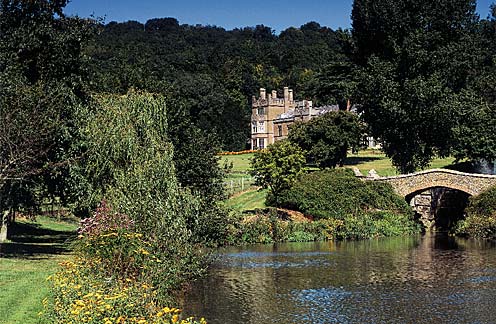Titsey Place and Gardens
Description
impression now is of a comfortable early-nineteenth century house in a picturesque park, under the North Downs which hereabout rise to over 800 feet. It is difficult to believe that this well-preserved stretch of country is barely twenty miles from the centre of London: only the M25 motorway intrudes into a landscape which otherwise has hardly changed in the last hundred years. The estate was originally bought in 1534 by Sir John Gresham, of the famous London merchant dynasty, and descended in the early-nineteenth century through the female line to the Leveson Gowers, a cadet branch of the family of the Dukes of Sutherland. The Leveson Gower family lived at Titsey until the death of Thomas Leveson Gower in 1992.
The last generation of Leveson Gowers, being bachelors and having no close relations, had given much thought to the future of Titsey. Richard and Thomas Leveson Gower set up the Titsey Foundation, a charitable trust, to preserve the estate for public benefit. Following the death of Thomas Leveson Gower, the last of the Leveson Gowers of Titsey, David Innes was asked by the trustees to accept the position of governor of the foundation. Mr Innes had been well-acquainted with the house and estate since the late 1940s. Thomas Leveson Gower had taken on the role of guardian to the Innes family under the will of Mr Innes’s father, who had died in 1948. Mr and Mrs Innes, working with the foundation’s trustees, have been largely responsible for the restoration of the house, with advice on the interiors from Jean Monro, and of the gardens, with the help of Elizabeth Banks. House, garden and re-created kitchen garden are now opened to the public in the summer, and miles of well-marked woodland walks on the side of the North Downs are frequented by more than 20,000 visitors a year.
The surroundings of Titsey, as they are today, are largely the work of William and Granville Leveson Gower in the nineteenth century. They planted the park and laid out the garden. William Leveson Gower was responsible in particular for the hillside beech plantation, which covers 210 acres and is such a feature of the setting, and for the ha-ha in front of the house. In the sixteenth century the surroundings were very different. The village of Titsey, including the church, a mill and malthouse, was situated next to the house where the formal lawn and flower gardens are today. The church of St. James was moved to its present site on the other side of the turnpike road by Sir John Gresham in 1776 when he made a small park. It was rebuilt by Granville Leveson Gower to the design of J.L. Pearson, one of the greatest Victorian Gothic Revival Architects. Although comparatively small in scale, it is a powerful piece of architecture and contains family monuments in the vaulted chapel next to the chancel. It was built in 1860-61 and cost £6,000. The outside is of Limpsfield sandstone but the interior makes a proud display of mid-Victorian polychromy faced in Bath stone and inlaid and embellished with green Godstone,firestone, red Devonshire and Green Galway marbles.
The stained glass is by Clayton & Bell, the encaustic tiles in the chancel by Minton and the carved oak work by Rattee & Kett of Cambridge. The effect is crisp and impressive. The shingled spire makes a landmark in the garden. Titsey village itself is now entirely a model estate hamlet with picturesque stone and black and white cottages, mainly designed by the local architects Whichard & Walker,
though George Devey also supplied designs for a lodge. The old site of the church is marked only by the ancient yew tree south of the house which now presides over the dogs’ graves. It is reputed to be 1,000 years old. Granville Leveson Gower and his wife Sophia laid out the terraces with stone steps, and formal beds with box hedges to the south of the house.





